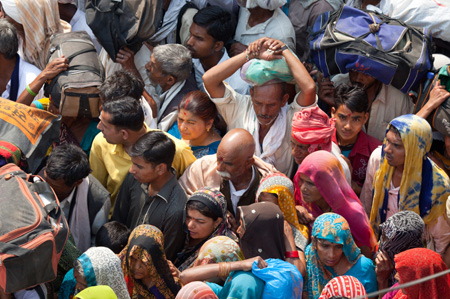
On 30 and 31 July this year, about half of India--or roughly 10 percent of the world's population--suddenly found they had no electricity. A failure of this magnitude has never happened before. But while the timing of the incident could not have been predicted, the signs have been visible for many years.
If more Indians are to enjoy the benefits of a middle-class life, the country has to ensure that the availability of electricity increases roughly in line with economic growth. If India has to compete favourably with its Asian neighbours, it would have to increase its per capita electricity consumption. Per capita electricity consumption in China is about 3.5 times that of India; Malaysia, 6.33 times that; Singapore, 14 times; and South Korea, 16.6 times. Competition between the countries would only increase, and unless India can significantly increase the availability of electricity, its competitive position will erode.
Hydro and coal account for nearly 77 percent of electricity generation in India. Take hydro. Only about one-fourth of the country's hydro potential has been harnessed. Lack of vision, the populist tone of much of the country's politics, social and environmental activism, slow decision-making, and weak law enforcement have ensured that hydro power contributes to only about 20 percent of electricity generation.
In April, Secretary of Power Uma Shankar announced a reduction of the planned hydropower-generating capacity for the next five years--from 30GW to 10GW--because of regulatory delays, problems with land acquisition and poor planning practices. This is in marked contrast to the progress that countries like China have made in hydro development. Because of India's chaotic planning process, the country simply could not have built the Three Gorges Dam, which now accounts for about 10 percent of China's electricity use.
Coal accounts for more than half of India's electricity generation. The country has the world's fifth-largest reserve of coal, but its quality is poor because of very high ash content. Coal India has not been increasing production fast enough. Compared with China's exponentially increasing output, Indian production has remained almost stationary during the past two years. Existing mines have strict limits as to how much coal they can extract. New mines are difficult to open because of the trouble in obtaining environmental and land clearances.
Coal prices, which are fixed by the government, are below international levels. Coal India has US$11 billion of unused net cash in its balance sheet, but reinvests only about 20 percent of its gross cashflow. Technology and management practices in mining and transportation are outdated. Management is weak because of strong trade unions and the system is rife with corruption.
Most consumers, meanwhile, receive heavily-subsidised electricity. Farmers get free power to pump groundwater for irrigation, but some of this free power is illegally diverted to factories. Since electricity is free, farmers run their pumps whether or not crops require water. As a result, groundwater levels in many states are declining by over 1m every year. This means each year, farmers have to use more electricity to pump water from increasing depths, thus accelerating this vicious circle.
Government-owned distributors in most states can no longer buy adequate power because they are politically forced to sell power cheap. Lack of modernisation, poor operation and maintenance practices and pilferage ensure that 30-40 percent of electricity generated is lost and do not produce any revenue.
Meanwhile, electricity-generating companies in the private sector do not get enough coal from Coal India, or cannot get the Indian Railways to transport it on time. These companies have spent over US$7 billion in buying coal mines abroad. Since the price at which they can sell power to the distributors is low, import of coal is not economically attractive.
The most important challenge facing the power sector is the multiplicity of actors with different agendas and interests. At the Central level there are various ministries, policymakers and regulatory institutions that often work at cross purposes. There is no one who can knock together the heads of the squabbling politicians and bureaucrats so that an agreed policy is followed, which would ensure adequate power for the country's long-term development.
Similar complexities lie at the state level. In addition, there are, on the one hand, powerful business empires whose tentacles entangle Central and state politics and bureaucracy, and on the other hand, single-issue environmental and social activists.
The result is that electrical infrastructure development has been neglected for decades. Even now, inter-regional transmission capacity is only about one-eighth of installed capacity. For India to grow at 8 to 10 percent a year, energy security is a prerequisite. For the 8th, 9th and 10th Plans, barely half the targets were achieved. Without assured supply of electricity, India will not be able to fulfil the aspirations of its growing and increasingly urbanising population.
BY: Prof Asit K Biswas, Third World Centre for Water Management